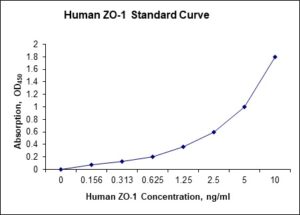Nori Human ZO-1 ELISA Kit
$461.00 – $832.00
This ELISA kit is for quantification of ZO-1 in human. This is a quick ELISA assay that reduces time to 50% compared to the conventional method, and the entire assay only takes 3 hours. This assay employs the quantitative sandwich enzyme immunoassay technique and uses biotin-streptavidin chemistry to improve the performance of the assays. An antibody specific for ZO-1 has been pre-coated onto a microplate. Standards and samples are pipetted into the wells and any ZO-1 present is bound by the immobilized antibody. After washing away any unbound substances, a detection antibody specific for ZO-1 is added to the wells. Following wash to remove any unbound antibody reagent, a detection reagent is added. After intensive wash a substrate solution is added to the wells and color develops in proportion to the amount of ZO-1 bound in the initial step. The color development is stopped, and the intensity of the color is measured.
Alternative names for ZO-1: Zonula occludens-1, tight junction protein 1, TJP1
This product is for Laboratory Research Use Only not for diagnostic and therapeutic purposes or any other purposes.
- Description
- How Elisa Works
- Product Citation (0)
- Reviews (0)
Description
Nori Human ZO-1 ELISA Kit Summary
Alternative names for ZO-1: Zonula occludens-1, tight junction protein 1, TJP1
| Assay Type | Solid Phase Sandwich ELISA |
| Format | 96-well Microplate or 96-Well Strip Microplate |
| Method of Detection | Colorimetric |
| Number of Targets Detected | 1 |
| Target Antigen Accession Number | Q07157 |
| Assay Length | 3 hours |
| Quantitative/Semiquantitative | Quantitative |
| Sample Type | Plasma, Serum, Cell Culture, Urine, Cell/Tissue Lysates, Synovial Fluid, BAL, |
| Recommended Sample Dilution (Plasma/Serum) | No dilution for sample <ULOQ; sufficient dilution for samples >ULOQ |
| Sensitivity | 30 pg/mL |
| Detection Range | 0.156-10 ng/mL |
| Specificity | Human ZO-1 |
| Cross-Reactivity | < 0.5% cross-reactivity observed with available related molecules, < 50% cross-species reactivity observed with species tested. |
| Interference | No significant interference observed with available related molecules |
| Storage/Stability | 4 ºC for up to 6 months |
| Usage | For Laboratory Research Use Only. Not for diagnostic or therapeutic use. |
| Additional Notes | The kit allows for use in multiple experiments. |
Standard Curve
Kit Components
1. Pre-coated 96-well Microplate
2. Biotinylated Detection Antibody
3. Streptavidin-HRP Conjugate
4. Lyophilized Standards
5. TMB One-Step Substrate
6. Stop Solution
7. 20 x PBS
8. Assay Buffer
Other Materials Required but not Provided:
1. Microplate Reader capable of measuring absorption at 450 nm
2. Log-log graph paper or computer and software for ELISA data analysis
3. Precision pipettes (1-1000 µl)
4. Multi-channel pipettes (300 µl)
5. Distilled or deionized water
Protocol Outline
1. Prepare all reagents, samples and standards as instructed in the datasheet.
2. Add 100 µl of Standard or samples to each well and incubate 1 h at RT.
3. Add 100 µl of Working Detection Antibody to each well and incubate 1 h at RT.
4. Add 100 µl of Working Streptavidin-HRP to each well and incubate 20 min at RT.
5. Add 100 µl of Substrate to each well and incubate 5-30 min at RT.
6. Add 50 µl of Stop Solution to each well and read at 450 nm immediately.
Background:
Zonula occludens-1 (ZO-1), also known as Tight junction protein-1 (TJP1) is a 220-kD peripheral membrane protein that is encoded by the TJP1 gene.[1] It belongs to the family of zonula occludens proteins (ZO-1, ZO-2, and ZO-3), which are tight junction-associated proteins and of which, ZO-1 is the first to be cloned. It was first isolated in 1986 by Stevenson and Goodenough using a monoclonal antibody raised in rodent liver to recognise a 225-kD polypeptide in whole liver homogenates and in tight junction-enriched membrane fractions.[6] It has a role as a scaffold protein which cross-links and anchors Tight Junction (TJ) strand proteins, which are fibril-like structures within the lipid bilayer, to the actin cytoskeleton.[2] ZO-1 is located on a cytoplasmic membrane surface of intercellular tight junctions and may be involved in signal transduction at cell–cell junctions. Two transcript variants encoding distinct isoforms have been identified for this gene. Lens connexins alpha3Cx46 and alpha8Cx50 interact with zonula occludens protein-1 (ZO-1).[3] The gap junction protein connexin43 interacts with the second PDZ domain of the zona occludens-1 protein.[4] The tight junction protein ZO-1 establishes a link between the transmembrane protein occludin and the actin cytoskeleton.[5] Tyrosine phosphorylation and dissociation of occludin-ZO-1 and E-cadherin-beta-catenin complexes from the cytoskeleton by oxidative stress.[6]
References
- Mohandas TK, et al. (1995). Genomics. 30 (3): 594–7.
- Itoh M, et al. (1997). The Journal of Cell Biology. 138 (1): 181–92.s
- Nielsen PA, et al. (2003). Molecular Biology of the Cell. 14 (6): 2470–81.
- Giepmans BN, Moolenaar WH (1998). Current Biology. 8 (16): 931–4.
- Fanning AS, et al. (1998). The Journal of Biological Chemistry. 273 (45): 29745–53.
- Rao RK, et al. (2002). The Biochemical Journal. 368 (Pt 2): 471–81.
Be the first to review “Nori Human ZO-1 ELISA Kit”
You must be logged in to post a review.






























Reviews
There are no reviews yet.